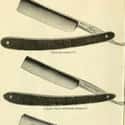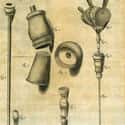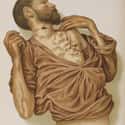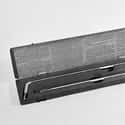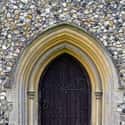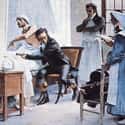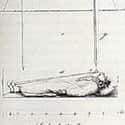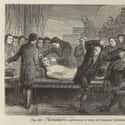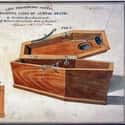-
(#1) Slicing And Burning The Feet And Putting Needles Under The Toenails
The feet are one of the most sensitive parts of the body – but only while a body is still alive. To determine whether someone was truly dead, physicians came up with all sorts of horrific foot tortures, including cutting corpses’s soles with razors. Another brutal method was shoving needles under their toenails or applying red-hot irons to the feet. If the body passed the "foot torture test," it could be safely buried.
-
(#2) Funneling A Tobacco Smoke Enema Up Someone's Rectum
Who knew all the uses of tobacco? The tobacco smoke enema was a surefire way of reviving drowning victims in the late 18th century. Starting around 1774, “pipe smoker London Medics” would insert an enema tube into a drowning victim and blow smoke into the rectum.
The device was thought to work two ways: it would warm the body, and it would stimulate respiration. But the tobacco smoke enema had its dangers, too: if the medic accidentally inhaled instead of exhaling, he might breathe in cholera and kill himself. Eventually, practitioners introduced a bellows so that medics didn't have to blow smoke directly up people’s bums.
-
(#3) Inserting A Long Needle With A Flag Attached Into The Heart
A German scientist named Middeldorph came up with a test called the heart flag to test for death. The heart flag was a long needle that Middeldorph told doctors to thrust into the heart of a seemingly dead body. If the heart was still beating, a flag would pop up and unfurl, proving that the person was still alive.
This was not just a hypothetical test – it was used on multiple people. In 1893, a doctor named Séverin Icard used the heart flag on a dead body to prove to the woman's relatives that she would not be buried alive. Unfortunately for Icard, the woman’s family accused him of killing her with the heart flag. It became a scandal in the presses.
-
(#4) Dumping Scalding Water On The Body
The scalding cure was exactly what it sounds like: dumping scalding water onto an unconscious body to see if it came back to life. An Englishman named Barnett devised a slightly more rigorous scalding test, which recommended burning a patch of skin on the arm to see if it blistered. According to Barnett, if the skin did not blister, there was no life left in the body. Along similar lines, some doctors recommended burning a body's nose to shock the person back to life.
-
(#5) Chopping Off A Finger
Many 18th and 19th-century death tests involved fingers. One gruesome way to test for death was chopping off a person’s finger. It was thought that the shock might bring a body back to life – or prove that the person was actually dead. Other tests involving fingers included holding them over a candle flame or looking for blood circulation at the finger tips. At least that sounds less painful than having a finger chopped off.
-
(#6) Sticking A Thermometer In The Corpse's Stomach
One surefire way to determine if a person was really dead was using a thermometer. But in the 19th century, doctors didn’t mess around with an under-the-tongue measurement. In 1841, Christian Friedrich Nasse developed a thanatometer – a long thermometer that could be inserted into the corpse’s stomach. The thermometer could then measure the core body temperature to determine if life was possible.
Of course, shoving a thermometer into the person’s stomach might also cause a reaction if the person wasn’t actually dead.
-
(#7) Waiting For It To Start Rotting
The concept of a waiting mortuary was relatively simple: a dead body would be kept for several days in a mortuary to make sure that it started to decompose before it was buried. The concept became so popular that many sprung up in Germany in the late 1800s.
But in practice, the waiting mortuary had a few problems. For one, nurses didn’t enjoy watching over a ward full of corpses. But decomposition posed an even bigger issue. To mask the smell of rotting flesh, waiting mortuaries packed in flower arrangements between the corpses.
-
(#8) Rhythmically Pulling The Tongue For Three Hours
If manipulating the tongue helped during artificial respiration, why not tug on it to see if a corpse was actually dead? That was the suggestion from Dr. J.V. Laborde, who recommended rhythmically pulling the deceased’s tongue for three hours.
According to Laborde, he had once successfully revived an unconscious woman by yanking her tongue with strong forceps. The woman complained that the pain was excruciating, but at least she was alive. Laborde even invented a tongue-pulling machine for mortuaries. Even unskilled mortuary assistants could turn the crank, determining whether a body was truly dead before it was buried.
-
(#9) Leaving The Corpse A Bell To Ring Just In Case It Wasn't Dead
This tool, developed by German doctor Johann Taberger, was called a safety coffin. It built on an earlier model that placed a key in the pocket of every dead body so they could open the coffin from the inside. Taberger's version included ropes that linked the corpse to a bell above ground. If the "corpse" woke in the coffin, he could alert the living by ringing the bell. There was only one problem with Taberger's design: bloating caused by decomposition could cause the corpse to shift and set off false alarms that would horrify the living.
-
(#10) Electrically Shocking The Face
Galvanism, or the process of using electricity to cause muscle contractions, was cutting-age science in the early 18th century. Scientist Luigi Galvani proclaimed that electricity was the force of life in 1791, and the technique even inspired Mary Shelley’s Frankenstein. So it’s no wonder that doctors came up with a galvanism death test.
In 1805, Christian August Struwe suggested using electricity to shock a corpse’s eye and lip – if the person was still alive, there would be a muscle twitch. Unfortunately, the equipment was so expensive that the galvanism death test did not catch on – in spite of images that implied the test was foolproof.
-
(#11) Using The Gases Released By The Body To Reveal Invisible Ink
Doctor Séverin Icard came up with a death test in the late 19th century that almost seemed like a magic trick. Icard used acetate of lead to write the phrase “I am really dead” on a piece of paper. The words were invisible until he placed the paper on the corpse’s nose. If the body was releasing sulfur dioxide, present in putrefactive gases, the invisible words would appear on the paper like magic.
However, in a time before modern dentistry, decaying teeth or tonsillitis could also create sulfur dioxide, creating false positives.
-
(#12) Burying It In A Coffin It Could Easily Get Out Of If Need Be
In 1843, Christian Eisenbrandt took out a patent on his life-preserving coffin, which he called a “coffin to be used in cases of doubtful death.” The coffin worked in two ways: instead of typical hinges, it had levers and springs attached to a ring on the occupant’s finger. Any movement from the corpse would cause the coffin to pop open. In addition, the life-preserving coffin had a mesh top, which prevented suffocation. Eisenbrandt suggested keeping the coffin in a vault until decomposition began.
-
(#13) Putting The Corpse's Finger In Your Ear And Listening For Life
Dr. Leon Collongues believed that his ear could test for death. He claimed that when he placed the finger of a living person into his ear, he heard a buzzing sound due to slight muscle movements and capillary functions. A dead person’s finger made no sound. And Collongues didn’t just want to stick people’s fingers in his ear to see if they were dead – he also argued that the nature of the buzzing sound could be used to diagnose diseases.
-
(#14) Rubbing The Body With A Prickly Bush
A forensic specialist named Professor M. Weber developed his own test for death, which involved prickly bushes. He recommended rubbing a hard brush over the dead body’s skin a few hours after death. If the person was truly deceased, the skin would appear to have a parchment-like texture after the rubbing. Weber’s technique was so esteemed that he won a 5,000-franc prize from the Academy of Sciences in Paris.
New Random Displays Display All By Ranking
About This Tool
Their bodies did not rot and even still warm, their stomachs gurgled and blood was still flowing. However, according to most medical assessments, these patients have completely died. is it possible? How did the doctor determine that they were actually dead? Confirming death is not easy. In Europe in the 18th century, people had more than 30 methods for making sure a corpos was dead, including clamping the nipple with pliers and putting leeches into the human anus.
It is certain that modern medical institutions do not think these methods are convincing. Over the centuries, humans have initiated a series of revolutionary new technologies to confirm death. The random tool brings us back to the 18th century to explore 14 weird ways to make sure the corpses were dead.
Our data comes from Ranker, If you want to participate in the ranking of items displayed on this page, please click here.











